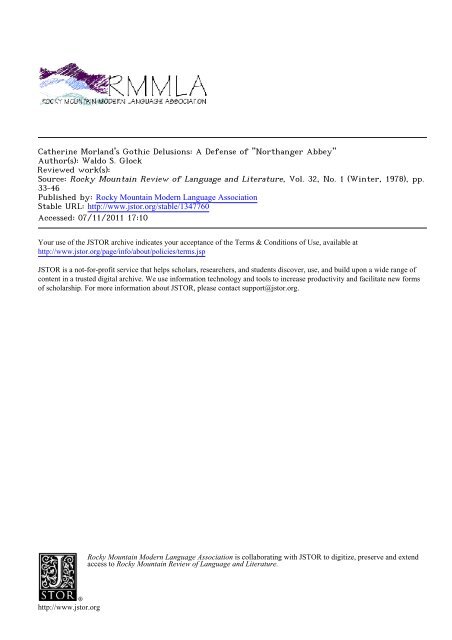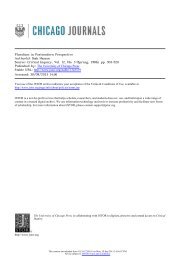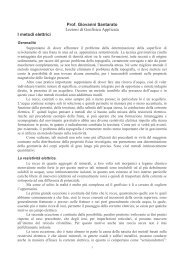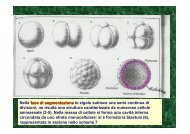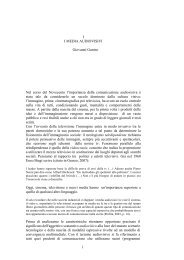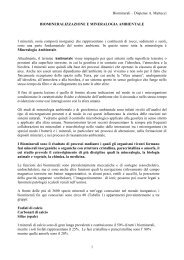Catherine Morland's Gothic Delusions: A Defense of "Northanger ...
Catherine Morland's Gothic Delusions: A Defense of "Northanger ...
Catherine Morland's Gothic Delusions: A Defense of "Northanger ...
Create successful ePaper yourself
Turn your PDF publications into a flip-book with our unique Google optimized e-Paper software.
<strong>Catherine</strong> <strong>Morland's</strong> <strong>Gothic</strong> <strong>Delusions</strong>: A <strong>Defense</strong> <strong>of</strong> "<strong>Northanger</strong> Abbey"<br />
Author(s): Waldo S. Glock<br />
Reviewed work(s):<br />
Source: Rocky Mountain Review <strong>of</strong> Language and Literature, Vol. 32, No. 1 (Winter, 1978), pp.<br />
33-46<br />
Published by: Rocky Mountain Modern Language Association<br />
Stable URL: http://www.jstor.org/stable/1347760 .<br />
Accessed: 07/11/2011 17:10<br />
Your use <strong>of</strong> the JSTOR archive indicates your acceptance <strong>of</strong> the Terms & Conditions <strong>of</strong> Use, available at .<br />
http://www.jstor.org/page/info/about/policies/terms.jsp<br />
JSTOR is a not-for-pr<strong>of</strong>it service that helps scholars, researchers, and students discover, use, and build upon a wide range <strong>of</strong><br />
content in a trusted digital archive. We use information technology and tools to increase productivity and facilitate new forms<br />
<strong>of</strong> scholarship. For more information about JSTOR, please contact support@jstor.org.<br />
http://www.jstor.org<br />
Rocky Mountain Modern Language Association is collaborating with JSTOR to digitize, preserve and extend<br />
access to Rocky Mountain Review <strong>of</strong> Language and Literature.
<strong>Catherine</strong> <strong>Morland's</strong> <strong>Gothic</strong> <strong>Delusions</strong>:<br />
A <strong>Defense</strong> <strong>of</strong><strong>Northanger</strong> Abbey<br />
WALDO S. GLOCK<br />
The critical response to <strong>Northanger</strong> Abbey has been neither consistent<br />
nor entirely unambiguous. Most critics have recognized that a<br />
problem exists, a problem connected with the success or failure with<br />
which Jane Austen has integrated into the body <strong>of</strong> <strong>Catherine</strong> <strong>Morland's</strong><br />
ordinary adventures a substantial element <strong>of</strong> <strong>Gothic</strong> burlesque. Although<br />
it is the third novel written by Jane Austen, <strong>Northanger</strong> Abbey was<br />
evidently less extensively revised than the early versions <strong>of</strong> Sense and<br />
Sensibility and Pride and Prejudice. It therefore seems to contain more<br />
<strong>of</strong> Jane Austen's early work than the two earlier novels, and certainly<br />
the prominence given to the parody <strong>of</strong> <strong>Gothic</strong> romance links <strong>Northanger</strong><br />
Abbey to such juvenile work as Love and Freindship.<br />
Numerous critics have insisted that the burlesque is imperfectly<br />
joined to the main narrative, with the result that <strong>Catherine</strong>'s fantastic<br />
delusions at <strong>Northanger</strong> Abbey are regarded as deficient in logical<br />
connection with her earlier experiences at Bath. Her impressionable<br />
mind occasionally interprets scenes at Bath in the light <strong>of</strong> her reading<br />
<strong>of</strong> <strong>Gothic</strong> romance, and she succumbs to excited anticipations <strong>of</strong> viewing<br />
Blaize Castle; but-so the argument goes-none <strong>of</strong> these temporary enthusiasms<br />
quite prepares the reader for the excessive credulity with which<br />
<strong>Catherine</strong> becomes the victim <strong>of</strong> <strong>Gothic</strong> illusion at <strong>Northanger</strong> Abbey.<br />
The alteration in her character, the seeming use <strong>of</strong> her as a satiric<br />
device, without apparent regard for the principles <strong>of</strong> consistency and<br />
convincing reality, persuade many critics to question the structural<br />
unity <strong>of</strong> the novel. Jane Austen, they imply, surely would have purged<br />
her work <strong>of</strong> such youthful extravagances had she revised <strong>Northanger</strong><br />
Abbey as extensively as she did Pride and Prejudice.<br />
Waldo S. Glock teaches at New Mexico State University.<br />
ROCKY MOUNTAIN REVIEW 33
Typical <strong>of</strong> this kind <strong>of</strong> criticism is that <strong>of</strong> Anne Ehrenpreis in her<br />
introduction to the Penguin English Library edition <strong>of</strong> the novel. The<br />
formal relationship between the "Bath episodes and the <strong>Northanger</strong><br />
experience is not comfortable, and <strong>Catherine</strong>'s adventures at <strong>Northanger</strong><br />
are not a natural consequence <strong>of</strong> her reading." Once <strong>Catherine</strong> has<br />
arrived at the Abbey, she no longer functions as an anti-heroine, but<br />
proceeds to behave as irrationally as a "conventional <strong>Gothic</strong> prima<br />
donna, basing absurd conclusions on the slightest evidence." She becomes<br />
a different person, a prey to morbid fantasies, and "There is no<br />
way to accept this shift in <strong>Catherine</strong>'s character as psychologically convincing."<br />
1 In other words, Mrs. Ehrenpreis is arguing that the bu: lesque<br />
passages, especially Chapters v-ix <strong>of</strong> Volume II, are structurally and<br />
thematically opposed to the main plot in which Jane Austen depicts a<br />
young lady's entrance into the world. The Evelina theme is interrupted,<br />
and the aesthetic unity <strong>of</strong> the whole seriously damaged, by the author's<br />
playful insistence that <strong>Catherine</strong> is, in spite <strong>of</strong> the evidence <strong>of</strong> her unheroic<br />
nature, a romantic heroine after all.<br />
Similar critical detraction is widespread, and emphasizes the large<br />
number <strong>of</strong> readers who experience a sense <strong>of</strong> discomfort, even <strong>of</strong> dismay,<br />
at the apparent "breach in the imaginative continuity <strong>of</strong> <strong>Northanger</strong><br />
2 Abbey." <strong>Catherine</strong>'s deliberate pursuit <strong>of</strong> her <strong>Gothic</strong> illusions, according<br />
to McKillop, "jolts the story rather violently," connecting <strong>Northanger</strong><br />
Abbey with Jane Austen's earlier efforts at crude burlesque. To<br />
Mary Lascelles the burlesque pattern is "not subtly interwoven with<br />
the rest <strong>of</strong> the fabric," largely because the relationship is tenuous<br />
between "<strong>Catherine</strong>'s fancied and her actual adventures at the climax<br />
<strong>of</strong> the story."3 General Tilney's cruel dismissal, in other words, is<br />
neither caused by nor related to her extravagant misconception <strong>of</strong> him.<br />
The problem <strong>of</strong> unity, then, raises certain questions about the rela-<br />
'Jane Austen, <strong>Northanger</strong> Abbey (Harmondsworth, England: Penguin Books, 1972), pp.<br />
13 and 16.<br />
2Alan D. McKillop, "Critical Realism in <strong>Northanger</strong> Abbey," in Jane Austen: A Collection<br />
<strong>of</strong> Critical Essays, ed. Ian Watt (Englewood Cliffs, N.J.: Prentice-Hall, 1963), p. 60.<br />
3Mary Lascelles, Jane Austen and Her Art (London: Oxford University Press, 1939), pp.<br />
59 and 64.<br />
34<br />
A DEFENSE OF NORTHANGER ABBEY
tion <strong>of</strong> part to part, and <strong>of</strong> theme to aesthetic intention, that suggest the<br />
impropriety <strong>of</strong> applying naturalistic or strictly logical standards to Jane<br />
Austen's novels. In life <strong>Catherine</strong>'s <strong>Gothic</strong> delusions would make her<br />
seem a fool; in <strong>Northanger</strong> Abbey they stand forth as a symbolic and<br />
psychological flaw suggesting, but not logically accounting for, the<br />
artistic existence <strong>of</strong> a person otherwise unconvincingly inconsistent. Her<br />
primary fault, the <strong>Gothic</strong> infatuation that seems to disrupt the harmonious<br />
balance <strong>of</strong> the novel, becomes the symbolic mark <strong>of</strong> <strong>Catherine</strong>'s<br />
charmingly enthusiastic enthrallment to the power <strong>of</strong> the imagination,4<br />
and to the persuasive power <strong>of</strong> literature to reconcile or transcend the<br />
commonplace logic <strong>of</strong> events.<br />
Even if we grant that <strong>Catherine</strong>'s obsession is unbelievably irrational,<br />
and that her confusion <strong>of</strong> art with life is unacceptably naive, we must<br />
still remember that Jane Austen's practice suggests unequivocally that<br />
she is as much concerned with design and pattern as with reproducing<br />
the fabric <strong>of</strong> human life exactly as it exists in the external world. In<br />
such a novel, structure becomes meaning in the general sense that the<br />
principles <strong>of</strong> balance, contrast, and relationship facilitate the dramatic<br />
exposition <strong>of</strong> the theme <strong>of</strong> <strong>Catherine</strong>'s growth into maturity and wisdom.<br />
The <strong>Gothic</strong> material, therefore, not only is integral to the themes <strong>of</strong> the<br />
novel, as pointed out by numerous critics,5 but also functions as part <strong>of</strong><br />
an overall formal pattern that itself symbolically evokes those themes.<br />
The contrast between the Bath and the <strong>Northanger</strong> Abbey scenes, for<br />
4 The ambiguous effect <strong>of</strong> <strong>Catherine</strong>'s delusions possibly accounts for the equally ambiguous<br />
nature <strong>of</strong> some critical comment: for example, A. Walton Litz, lane Austen: A Study <strong>of</strong> Her<br />
Artistic Development (New York: Oxford University Press, 1965), p. 59, argues that the<br />
"<strong>Gothic</strong> elements are a brilliant commentary on <strong>Catherine</strong>'s general character and behavior,"<br />
and then depreciates the structural coherence <strong>of</strong> the novel by insisting that they form<br />
"detachable units." If the parody supports the general themes, one would suppose that it would<br />
be integral to the novel's total structure, even though possibly irrelevant to the plot.<br />
5See Litz, pp. 62, 67, and 175: "Certainly the <strong>Gothic</strong> sections <strong>of</strong> the novel support its<br />
general themes. . .." Yasmine Gooneratne, Jane Atlsten (Cambridge: Cambridge University<br />
Press, 1970), pp. 58 and 60-61; Andrew H. Wright, Jane Austen's Novels: A Study in Stric-<br />
ture (New York: Oxford University Press, 1961), pp. 96 and 101; John K. Mathison, "<strong>Northanger</strong><br />
Abbey and Jane Austen's Conception <strong>of</strong> the Value <strong>of</strong> Fiction," ELH, 24 (1957), 146-49; Frank J.<br />
Kearful, "Satire and the Form <strong>of</strong> the Novel: The Problem <strong>of</strong> Aesthetic Unity in <strong>Northanger</strong><br />
Abbey," ELH, 32 (1965), 517; Sheridan Baker, "The Comedy <strong>of</strong> Illusion in <strong>Northanger</strong><br />
Abbey," Papers <strong>of</strong> the Michigan Academy <strong>of</strong> Science, Arts, and Letters, 51 (1966), 548-49.<br />
ROCKY MOUNTAIN REVIEW 35
example, measures the extent <strong>of</strong> <strong>Catherine</strong>'s education, and constitutes<br />
a symbolic contrast between Deception and Revelation, between <strong>Catherine</strong>'s<br />
childhood naivete and the disillusionment from which knowledge<br />
grows. In more specific terms, the parody <strong>of</strong> <strong>Gothic</strong> extravagance emphasizes<br />
meaning by symbolizing the part that fantasy plays in man's<br />
life, and the dangers <strong>of</strong> a too uncritical reliance on imagination unaided<br />
by judgment. Both parts <strong>of</strong> <strong>Northanger</strong> Abbey are thematically and<br />
structurally related, with contrasts <strong>of</strong> character, recurring motifs, and<br />
patterns <strong>of</strong> meaning representing a totality <strong>of</strong> form in which inconsistency<br />
<strong>of</strong> action is less injurious to the aesthetic equilibrium <strong>of</strong> the<br />
whole than it is to the pragmatic expectations <strong>of</strong> many critics.<br />
The theme <strong>of</strong> growth into knowledge and wisdom develops by way<br />
<strong>of</strong> contrasting layers <strong>of</strong> successive experiences, each contrasting variation<br />
on the theme affording a sense <strong>of</strong> balance and security to Jane<br />
Austen's novelistic world. The basic contrast is that between "the common<br />
feelings <strong>of</strong> common life" and "the refined susceptibilities, the<br />
tender emotions" that are characteristic <strong>of</strong> a heroine in romantic and<br />
sentimental fiction. The ambiguities involved in the contrast between<br />
the stereotyped heroine <strong>of</strong> fiction, which <strong>Catherine</strong> is not, and <strong>Catherine</strong><br />
as the technical "heroine," even though a most unheroic one, <strong>of</strong><br />
<strong>Northanger</strong> Abbey, are richly explored by the contrast between the Bath<br />
scenes and those at the Abbey, and lend to the story <strong>of</strong> <strong>Catherine</strong>'s development<br />
an ironic dimension that deepens even as it extends the basic<br />
structural contrast.<br />
<strong>Catherine</strong> does become a heroine, a heroine <strong>of</strong> modern life. She embarks<br />
on life, the author tells us, under "unpromising auspices" (p. 19),<br />
with neither the accomplishments nor the expectations <strong>of</strong> a true heroine.<br />
There is nothing heroic about <strong>Catherine</strong>'s nature or aspirations, and<br />
during the Bath episodes, even including her unexciting introduction to<br />
Henry Tilney, she encounters nothing other than what any ordinary<br />
young woman would normally experience. She is, in fact, the ordinary<br />
Woman <strong>of</strong> the nineteenth century, a creature <strong>of</strong> flesh and blood<br />
6 The Novels <strong>of</strong> lane Austen, ed. R. W. Chapman, 3rd ed. (London: Oxford University<br />
Press, 1933), p. 19. Subsequent references to <strong>Northanger</strong> Abbey in the text are to Volume<br />
V <strong>of</strong> this edition.<br />
36<br />
A DEFENSE OF NORTHANGER ABBEY
comically presented in such commonplace circumstances as to assume<br />
a symbolic status representing all those unknown persons whose lives<br />
will be uneventful, desperate, and tedious; whose lives will be as<br />
vacuous and unimportant as that <strong>of</strong> the future Emma Bovary. <strong>Catherine</strong><br />
does not turn out to be another Madame Bovary. But she seems at first<br />
to learn in the Abbey section <strong>of</strong> the novel, while trying to be a romantic<br />
heroine, that in the nineteenth century fantastic cruelty and extravagant<br />
adventures for their own sake exist only in second-rate novels. Evil<br />
exists, she soon discovers, but it is more <strong>of</strong>ten than not a calculating<br />
and low-spirited evil designed for such unexalted purposes as financial<br />
gain. In contrast to the sentimental heroine, Isabella Thorpe, whose<br />
sufferings are histrionically imitative <strong>of</strong> the <strong>Gothic</strong> ideal, <strong>Catherine</strong><br />
endures her outrageous ejection from the Abbey with quiet and unobtrusive<br />
dignity: the modern, real heroine, in other words, suffers inwardly,<br />
in the depths <strong>of</strong> her being, eschewing grand and romantic<br />
gestures that have lost their connection with historic fact.<br />
The most significant function <strong>of</strong> the parody element is to suggest<br />
that the romantic and sentimental type <strong>of</strong> heroine is no longer relevant<br />
for the nineteenth century. It is Isabella, not <strong>Catherine</strong>, who most convincingly<br />
embodies the dangers <strong>of</strong> romantic illusion in the modern<br />
world, and whose transparent insincerity functions as a social equivalent<br />
<strong>of</strong> the equally false reality <strong>of</strong> the sentimental novel. She maintains her<br />
role <strong>of</strong> "heroine" at Bath, in other words, primarily because the deceptive<br />
values <strong>of</strong> sentimental fiction are essentially similar to the selfish and<br />
mercenary values <strong>of</strong> society. The treacherous conduct <strong>of</strong> General Tilney,<br />
significantly instigated by Thorpe's exaggeration <strong>of</strong> the Morland<br />
fortune, represents Jane Austen's indictment <strong>of</strong> a society that regards<br />
the <strong>Gothic</strong> novel as serious literature. <strong>Catherine</strong>, on the other hand,<br />
must learn a different kind <strong>of</strong> heroism. She represents the modern<br />
world <strong>of</strong> plain fact, a world in which common sense and sincere intention,<br />
not sentimental gestures and exaggerated artifice, must be allowed<br />
to define the essential quality <strong>of</strong> modern life. She is a democratic heroine<br />
who seeks, not honor or fame, but individual fulfillment. She wants a<br />
family and domestic tranquillity, and the love and respect <strong>of</strong> a husband<br />
ROCKY MOUNTAIN REVIEW 37
whose marital integrity will anticipate the conventional orthodoxies <strong>of</strong><br />
mid-Victorian morality.<br />
The first two chapters <strong>of</strong> Volume I constitute a parodic introduction<br />
to <strong>Northanger</strong> Abbey. They have the effect <strong>of</strong> establishing the substantial<br />
and inescapable fact <strong>of</strong> life's general commonness, and <strong>of</strong><br />
defining both the moral milieu in which <strong>Catherine</strong> must learn to<br />
exist and the extent <strong>of</strong> Isabella's deviation from that world. The point<br />
<strong>of</strong> the <strong>Gothic</strong> scenes at <strong>Northanger</strong>, in fact, is to emphasize by contrast<br />
that <strong>Catherine</strong> cannot find happiness in fantasy and romantic<br />
retreat from reality; it can only be found in the acceptance <strong>of</strong> the general<br />
ordinariness <strong>of</strong> life, as epitomized by the witty and original, yet totally<br />
unromantic Henry Tilney.<br />
Jane Austen, <strong>of</strong> course, does recognize that a reciprocal relationship<br />
exists between life and literature, though she suggests that the relationship<br />
is never fixed or precise: <strong>Catherine</strong> attempting to emulate Emily<br />
St. Aubert is no less absurd, but much less dangerous, than Isabella,<br />
wrapped in the shimmering gown <strong>of</strong> romantic illusion, betraying James<br />
Morland for Captain Tilney. The opposition, however, is always complex:<br />
during the famous discussion <strong>of</strong> "horrid novels" in Chapter vi<br />
(Vol. I), <strong>Catherine</strong> exclaims that she would not have abandoned The<br />
Mysteries <strong>of</strong> Udolpho except to meet her dear friend, Isabella. Real life<br />
seems to draw her away from the illusionistic world <strong>of</strong> fiction, but the<br />
pervasive paradoxical structure <strong>of</strong> <strong>Northanger</strong> Abbey emphasizes the<br />
contrast with <strong>Catherine</strong>: Isabella's role-playing is as unreal as her appreciation<br />
and understanding <strong>of</strong> good novels. She has not read Sir<br />
Charles Grandison, "'an amazing horrid book'" (pp. 41-2) which she<br />
considers a subject <strong>of</strong> less importance than the clothes she is going to<br />
wear: "'But, my dearest <strong>Catherine</strong>, have you settled what to wear on<br />
your head tonight?'" The inversion <strong>of</strong> values implied by the juxtaposition,<br />
and especially the ironic implication that, given such a scale <strong>of</strong><br />
values, even literature is more significantly "real" than Isabella's notion<br />
<strong>of</strong> what constitutes social life, emphasize the symbolic function <strong>of</strong> her<br />
"fictional" existence. Even her language in the Bath episodes anticipates<br />
her later treachery by its dishonest inability to represent the truth. Her<br />
continual inflation <strong>of</strong> sentiment is marked by an unimaginative depen-<br />
38<br />
A DEFENSE OF NORTHANGER ABBEY
dence on the word "amazingly," 7 a dependence that suggests the vacuity<br />
<strong>of</strong> a mind forever looking inward on itself, for whom real persons, such<br />
as <strong>Catherine</strong>, are objects to be used and manipulated. The contrast between<br />
appearance and reality is imbedded not only in the action but<br />
more subtly in the ironic complexity <strong>of</strong> the language.<br />
<strong>Catherine</strong>'s failure to recognize Isabella's falsity is an aspect <strong>of</strong> her<br />
imaginative failure to embrace both worlds at once, the world <strong>of</strong> fiction<br />
and the world <strong>of</strong> tangible reality, in a rounded vision <strong>of</strong> life that comprehends<br />
the norms <strong>of</strong> common sense and the heights <strong>of</strong> creative aspiration.<br />
She therefore vacillates between the two poles <strong>of</strong> experience, not<br />
having learned the essential restraints and qualifications that prevent<br />
either the imagination or the reason from being regarded as the whole<br />
<strong>of</strong> life. When she attempts to play a role, to be "arch" by suggesting that<br />
Isabella is eagerly expecting James to appear in the Pump-room (pp.<br />
143-44), her aim misses; she has no experience in flaunting and repeating<br />
the romantic cliches <strong>of</strong> which Isabella's speech is generally composed.<br />
But at <strong>Northanger</strong>, when <strong>Catherine</strong> finally recognizes Isabella's heartlessness<br />
and insincerity, she refuses to imitate Isabella by playing an<br />
assumed role, and candidly confesses that she is not as much afflicted<br />
by Isabella's betrayal as she had expected. After <strong>Catherine</strong> awakens<br />
from the "visions <strong>of</strong> romance" (p. 199), she perceives the truth, that<br />
her delusions had been "voluntary" and "self-created," and that the "infatuation<br />
had been created, the mischief settled long before her quitting<br />
Bath" (p. 200) by her reading <strong>of</strong> romantic novels in which "perhaps" 8<br />
the truths <strong>of</strong> human nature were imperfectly reflected. <strong>Catherine</strong>, then,<br />
has abandoned one illusion that obscures the true nature <strong>of</strong> reality, her<br />
"self-created delusion" that Isabella is a genuine heroine; and she resolves<br />
to act and judge in the future with the "greatest good sense" (p. 201).<br />
The gradual revelation <strong>of</strong> the essential truth, that heroines <strong>of</strong> sensibility<br />
are largely "self-created" by an over-active imagination, parallels<br />
7When <strong>Catherine</strong> (p. 107) incorrectly uses the word, in a context that indicates she is<br />
mistaken in her belief that young men despise <strong>Gothic</strong> novels, Henry immediately points out<br />
the solecism: inaccurate thought is reflected in imprecise language. <strong>Catherine</strong>'s linguistic dis-<br />
tortions are not the consequence <strong>of</strong> vanity or affectation.<br />
See Baker, p. 551, for a convincing demonstration that <strong>Catherine</strong>'s belief that she has<br />
completely abandoned her illusions is itself a subtle form <strong>of</strong> self-deception.<br />
ROCKY MOUNTAIN REVIEW 39
the transformation <strong>of</strong> Henry Tilney from "another version <strong>of</strong> Isabella<br />
herself" '<br />
into a man <strong>of</strong> probity and common sense. In the Bath scenes<br />
he assumes a role, inconsistent with his real character, in order to entertain<br />
<strong>Catherine</strong> with displays <strong>of</strong> his knowledge and wit. He is a devotee<br />
<strong>of</strong> the <strong>Gothic</strong> novel, having "read hundreds and hundreds" (p. 107),<br />
and it is significantly he, not <strong>Catherine</strong> alone, who plays upon her<br />
"raised, restless, and frightened imagination" (p. 51) by describing" 'all<br />
the horrors that a building such as "what one reads about" may<br />
produce'" (p. 157). On the walk around Beechen Cliff he instructs her<br />
in the cult <strong>of</strong> the picturesque, insisting that a natural scene is beautiful<br />
only ins<strong>of</strong>ar as it is capable <strong>of</strong> "being formed into pictures" (p. 110). A<br />
view from the top <strong>of</strong> a high hill, she learns to her surprise, is unworthy<br />
<strong>of</strong> notice if it is incapable <strong>of</strong> picturesque arrangement. In other words,<br />
the picturesque also distorts reality, preventing a direct and pure appreciation<br />
<strong>of</strong> Nature just as <strong>Gothic</strong> exaggeration does not allow Isabella at<br />
Bath, or <strong>Catherine</strong> at <strong>Northanger</strong>, to exhibit essential human nature<br />
unalloyed by layers <strong>of</strong> pretense. But in Volume II Henry as well as<br />
<strong>Catherine</strong> learns a lesson from her infatuation in the Abbey and he<br />
henceforth represents for her the solidity <strong>of</strong> unadorned fact. His pose<br />
<strong>of</strong> a witty and sophisticated man <strong>of</strong> the world, a pose that intentionally<br />
sacrifices the truth to aesthetic theory or personal vanity, is abandoned<br />
as he recognizes its incongruity with one whose real feelings are "'most<br />
to the credit <strong>of</strong> human nature' " (p. 207).<br />
The <strong>Gothic</strong> novel, remaining popular throughout the 1790s, still<br />
retained sufficient vitality to provoke E. S. Barrett's burlesque, The<br />
Heroine, in 1813. No more apt or manageable symbol <strong>of</strong> the distortion<br />
<strong>of</strong> life for the sake <strong>of</strong> melodramatic and emotional effects, <strong>of</strong> the stultifying<br />
and futile pretense <strong>of</strong> an Isabella Thorpe, could have been selected<br />
at the end <strong>of</strong> the '90s when <strong>Northanger</strong> Abbey was first drafted. The<br />
<strong>Gothic</strong> novel was dishonest; that, after all, is the purpose <strong>of</strong> Jane<br />
Austen's satire, to point out that a real heroine <strong>of</strong> common life must<br />
display an honesty which scorns unnatural affectations.<br />
9Darrel Mansell, The Novels <strong>of</strong> lane Atsten: An Interpretation (New York: Barnes and<br />
Noble, 1973), p. 17. I am indebted to Mr. Mansell's perceptive study for several pertinent<br />
ideas.<br />
40<br />
A DEFENSE OF NORTHANGER ABBEY
The important point to notice-a point that bears directly on any<br />
defense <strong>of</strong> the <strong>Gothic</strong> chapters-is that <strong>Catherine</strong>'s delusions have been<br />
carefully prepared for in the Bath episodes. The sight <strong>of</strong> Beechen<br />
Cliff reminds <strong>Catherine</strong> <strong>of</strong> southern France about which she has read<br />
in The Mysteries <strong>of</strong> Udolpho, and a projected visit to Blaize Castle stirs<br />
her imagination: she thinks <strong>of</strong> it as though it were Udolpho, and imagines<br />
that the sight <strong>of</strong> its walls "might console her for almost anything"<br />
(p. 86), though significantly not for the disappointment <strong>of</strong> not going<br />
for a walk with the Tilneys. Already she is succumbing to the temptation<br />
<strong>of</strong> identifying objects and situations in life with those <strong>of</strong> which she<br />
has read; already in Volume I she is supposing that the world <strong>of</strong> <strong>Gothic</strong><br />
fiction possesses a reality almost as significant as that <strong>of</strong> real life. In<br />
Volume II she is thrilled by thoughts <strong>of</strong> <strong>Northanger</strong> Abbey, and when<br />
she actually spends a night amidst its ancient walls, and observes the<br />
cabinet and ebony chest <strong>of</strong> which she supposes Henry to have spoken,<br />
she falls almost but not completely under the spell <strong>of</strong> her inflamed<br />
imagination. The most consistently sustained delusion is that which<br />
concerns General Tilney, and even that fanciful misapprehension has<br />
its origin in <strong>Catherine</strong>'s sense at Bath that he is a formidable and daunting<br />
personage. The delusions at <strong>Northanger</strong> Abbey are the climax, only<br />
because the Abbey provides the greatest stimulation to <strong>Catherine</strong>'s<br />
imagination, <strong>of</strong> her tendency to allow her vision <strong>of</strong> life to be colored<br />
by her reading. The most famous example occurs during the walk<br />
around Beechen Cliff, when <strong>Catherine</strong> suddenly remarks during a<br />
political discussion that she has heard that "'something very shocking<br />
indeed, will soon come out in London'" (p. 112). Eleanor naturally<br />
supposes that <strong>Catherine</strong> refers to a political riot, and her astonishment<br />
when she learns <strong>of</strong> her error marks the contrast between unrestrained<br />
romanticism and nineteenth-century realism. As Henry correctly reminds<br />
Eleanor, the anticipated riot exists only in her own brain, since<br />
<strong>Catherine</strong>'s reference is only to a new <strong>Gothic</strong> novel that will shortly be<br />
published. He ridicules the possibility <strong>of</strong> a riot in London and implies<br />
that it could never happen in England. The pro<strong>of</strong> that Henry can be<br />
mistaken, that evil does exist in England, is emphatically demonstrated<br />
ROCKY MOUNTAIN REVIEW 41
y the events at <strong>Northanger</strong> Abbey which culminate in the General's<br />
gratuitous act <strong>of</strong> cruelty.<br />
Henry at first seems to be justified in his assurance, for the <strong>Gothic</strong><br />
episodes seem to imply that evil-violence, murder, rapine-is largely<br />
illusory in nineteenth-century England, a product more <strong>of</strong> a diseased<br />
imagination than <strong>of</strong> general probability. Perhaps, as Henry admonishes<br />
her when he discovers her searching Mrs. Tilney's apartment, such<br />
atrocities as she imagines the General to have committed could not occur<br />
in the nineteenth century, in a civilized country like England: "'Remember<br />
that we are English, that we are Christians. Consult your own<br />
understanding, your own sense <strong>of</strong> the probable, your own observation<br />
<strong>of</strong> what is passing around you-Does our education prepare us for such<br />
atrocities?'" (p. 197). The answer Jane Austen provides is two-fold:<br />
such violence and insecurity can indeed arise, even in tranquil and<br />
law-abiding England, from the unrestrained fantasies <strong>of</strong> one's own<br />
mind and the terrors <strong>of</strong> the subconscious; or they can be caused by the<br />
heartless self-interest <strong>of</strong> a General Tilney who represents a society for<br />
whom money has replaced honor as a guiding principle.<br />
Life seems secure and propertly protected: such is the popular opinion<br />
<strong>of</strong> the complacent reader as well as <strong>of</strong> Henry Tilney, a belief that Jane<br />
Austen ironically wishes to suggest is itself illusory. Her intention<br />
requires the inclusion <strong>of</strong> the <strong>Gothic</strong> chapters. That <strong>Catherine</strong> is not, in<br />
fact, quite so much in error as the <strong>Gothic</strong> burlesque would seem to imply,<br />
is one <strong>of</strong> the critical insights that have recently contributed to our<br />
greater understanding <strong>of</strong> Jane Austen.'? Her strategy is one <strong>of</strong> gradually<br />
increasing the insistency <strong>of</strong> the message. She first has Henry insist that<br />
no rational person would imagine that such horrors could exist outside<br />
<strong>of</strong> a circulating library novel (p. 113)-a point <strong>of</strong> subtle selfmockery<br />
since Henry <strong>of</strong>ten functions as the author's mouthpiece. Second,<br />
she has <strong>Catherine</strong> prove, by her supposing that life reflects secondrate<br />
literature, that there are sensible and rational persons such as<br />
10 See, for example, Lionel Trilling, The Opposing Self (New York: Viking, 1955), p. 207;<br />
D.W. Harding, "Regulated Hatred: An Aspect <strong>of</strong> the Work <strong>of</strong> Jane Austen," in lane Austen:<br />
A Collection <strong>of</strong> Critical Essays, ed. Ian Watt (Englewood Cliffs, N.J.: Prentice-Hall, 1963),<br />
pp. 167-68; Mathison, p. 149.<br />
42<br />
A DEFENSE OF NORTHANGER ABBEY
<strong>Catherine</strong> herself who can, momentarily and wholeheartedly, give way<br />
to the most fantastic suppositions under the combined influence <strong>of</strong> an<br />
over-stimulated imagination and cooperating circumstances (in this case,<br />
an old abbey). Third, Jane Austen proceeds to hint that, beneath the<br />
appearance <strong>of</strong> tranquillity <strong>of</strong> English society, " 'every man is surrounded<br />
by a neighbourhood <strong>of</strong> voluntary spies'" (p. 198). The suggestion ironically<br />
undercuts Henry's confident belief in the orderliness and security<br />
<strong>of</strong> English civilization, and anticipates the revelation <strong>of</strong> the full horror<br />
<strong>of</strong> which a commercial society is capable. Finally, with great explicitness,<br />
Jane Austen emphasizes her main point, that Henry is mistaken in his<br />
argument that fiction seldom reflects the realities <strong>of</strong> the everyday world:<br />
deceit and cruelty, almost rivalling those displayed in The Mysteries <strong>of</strong><br />
Udolpho, do exist in common life. The <strong>Gothic</strong> episodes imply that evil<br />
is illusory, that literature is not life; but evil is now shown to be real.<br />
The unexpected irony is that <strong>Catherine</strong>, though mistaken in the means<br />
by which evil is manifested, is not so far from the truth, unbeknown<br />
to herself, as is Henry Tilney.<br />
<strong>Catherine</strong> is an "anti-heroine" who learns from the General's cruelty<br />
that common sense will not alleviate the real horror <strong>of</strong> ordinary life;1<br />
not even Mrs. <strong>Morland's</strong> good sense can find an effective antidote to<br />
<strong>Catherine</strong>'s illness after her return to Fullerton. Unlike Isabella, who<br />
wretchedly entertains the illusion that she can resume her affair with<br />
James, <strong>Catherine</strong> sadly accepts her altered circumstances, and does not<br />
attempt to be other than she was three months earlier, a sincere and<br />
humble person without pretension and without vain ambitions. The<br />
essential difference is that now, returned to Fullerton after experiencing<br />
the purgatorial humiliation <strong>of</strong> being driven forth from <strong>Northanger</strong><br />
Abbey, from the world <strong>of</strong> childhood fancies and make-believe into the<br />
world <strong>of</strong> "actual and natural evil" (p. 227), she has endured the pain <strong>of</strong><br />
real life. She now is no longer "free from the apprehension <strong>of</strong> evil as<br />
from the knowledge <strong>of</strong> it" (p. 237).<br />
Her expulsion from <strong>Northanger</strong> symbolizes the sudden and almost<br />
traumatic experience <strong>of</strong> maturing, <strong>of</strong> losing her innocence. Returned to<br />
" Cf. Wright, p. 101: ". . . she learns that good sense cannot deal with the crisis that<br />
has forced her sudden expulsion."<br />
ROCKY MOUNTAIN REVIEW 43
her place <strong>of</strong> birth, having learned to love and be loved, <strong>Catherine</strong> is now<br />
prepared to begin adult life unencumbered by the fascinating yet irrelevant<br />
dreams <strong>of</strong> <strong>Gothic</strong> romance. All forms <strong>of</strong> falseness, <strong>of</strong> unreality are<br />
rejected in favor <strong>of</strong> intrinsic goodness; and even the reader is chastised<br />
for his delusion, the belief that <strong>Northanger</strong> Abbey is a mirror or transcript<br />
<strong>of</strong> life. Jane Austen's narrative technique, exploiting conscious<br />
and ambiguous irony, comically undercuts the apparently "objective"<br />
reality even <strong>of</strong> <strong>Catherine</strong> herself. The effect <strong>of</strong> the frequent authorial<br />
interruptions, as in the airy dismissal <strong>of</strong> the moral tendency <strong>of</strong> the work<br />
as either recommending parental tyranny or rewarding filial disobedience<br />
(p. 252), is to break the illusion that the created fictional world is<br />
real; it prevents the reader's ever confusing life and literature for long,<br />
and therefore stresses, by warning the reader not to succumb to <strong>Catherine</strong>'s<br />
mistake, the extent <strong>of</strong> her misunderstanding <strong>of</strong> the real nature<br />
<strong>of</strong> the imagination. Symbolically <strong>Catherine</strong> has violated the integrity<br />
<strong>of</strong> the artistic imagination-its self-sufficiency, its freedom from absolute<br />
domination by real life-by naively supposing an identity between literature<br />
and life. For that sin she must be driven forth, an Eve <strong>of</strong> the<br />
creative power, from the Abbey, from the physical embodiment <strong>of</strong><br />
<strong>Gothic</strong> romance amidst the commonplace reality <strong>of</strong> early nineteenthcentury<br />
England. Good does emerge paradoxically from evil. From the<br />
darkness <strong>of</strong> the Abbey, from the delusion that the <strong>Gothic</strong> novel's simple<br />
reduction <strong>of</strong> human nature into stark contrasts <strong>of</strong> good and evil is an<br />
accurate representation <strong>of</strong> the world about her, she emerges into the<br />
sunlight <strong>of</strong> nineteenth-century rationality. Reason may seem the epitome<br />
<strong>of</strong> unexciting mediocrity, but without rational control <strong>of</strong> the imagination<br />
no sane and life-enhancing art, even that <strong>of</strong> <strong>Northanger</strong> Abbey's<br />
<strong>Gothic</strong> parody, is possible.<br />
The ultimate paradox, in fact, resides in the contrast between form<br />
and content. The theme <strong>of</strong> the novel emphasizes the attractions <strong>of</strong> the<br />
real world, <strong>of</strong> common experience and unromantic aspirations, and the<br />
need for <strong>Catherine</strong> to abandon the illusions <strong>of</strong> immaturity; yet her experiences<br />
are so consciously ordered and selectively rendered as to underline<br />
the contrary attraction <strong>of</strong> the world <strong>of</strong> art. <strong>Northanger</strong> Abbey asks<br />
the question: Which is more real, the implied real world in which an<br />
44<br />
A DEFENSE OF NORTHANGER ABBEY
Isabella can prefer "'my yellow gown, with my hair done up in braids"'<br />
(p. 118) to her false love for James Morland to whom she has "irrecoverably"<br />
lost her heart, or the "unreal," fantastic, totally improbable<br />
world <strong>of</strong> suspicions and delusions to which <strong>Catherine</strong> succumbs in a<br />
"<strong>Gothic</strong>" novel? Isabella is so obviously an "unreal" figure even in the<br />
world <strong>of</strong> sentimental fiction, so obviously in her total presentation such<br />
a devastatingly shallow imitation <strong>of</strong> any real person, that ins<strong>of</strong>ar as she<br />
may stand for the non-fictional world <strong>of</strong> empirical reality she emphasizes<br />
by contrast the intensely "living" existence <strong>of</strong> <strong>Catherine</strong> Morland.<br />
<strong>Catherine</strong>, the product <strong>of</strong> the art <strong>of</strong> parody, <strong>of</strong> the imaginative arranging<br />
and distorting <strong>of</strong> life for the sake <strong>of</strong> artistic effect, is more "real" finally<br />
even with her delusions than the described world <strong>of</strong> external reality<br />
represented by Isabella. The paradoxical contrast suggests that art, the<br />
great illusion, is more "real" than real life. The final effect, perhaps the<br />
real meaning <strong>of</strong> <strong>Northanger</strong> Abbey, is to emphasize the integrity and<br />
importance <strong>of</strong> the literary imagination.<br />
The meaning <strong>of</strong> <strong>Catherine</strong>'s adventures, including her <strong>Gothic</strong> aberrations<br />
at <strong>Northanger</strong>, is indissolubly a part <strong>of</strong> the formal structure <strong>of</strong><br />
the novel. Without the dual form in which pairs <strong>of</strong> opposites are<br />
dramatically illustrated, especially the contrast between reason and<br />
imagination, the growth <strong>of</strong> wisdom and experience in <strong>Catherine</strong> Morland<br />
would be not only incomplete but also formally chaotic and therefore<br />
aesthetically meaningless. In the penultimate chapter, where the<br />
contrast between romance and common life is repeated from Chapter ii<br />
(Vol. I), Jane Austen achieves a resolution <strong>of</strong> the antithesis between<br />
<strong>Gothic</strong> romance and the reality <strong>of</strong> everyday life in the achievement <strong>of</strong><br />
her own novel: <strong>Gothic</strong> extravagance does have a place in literature if it<br />
serves an aesthetic rather than an empirical function. She seems to banish<br />
romantic material from the novel in the comic finality <strong>of</strong> <strong>Catherine</strong>'s<br />
humiliation, but ironically allows it a legitimate existence by the formal<br />
success with which she has employed the <strong>Gothic</strong> episode.<br />
The synthesis <strong>of</strong> opposites is significantly exposed in the final scenes<br />
at Fullerton, for in them it is all too plain that neither common sense<br />
nor unrestrained fancy has been sufficient to bestow happiness on<br />
<strong>Catherine</strong>. Henry Tilney, having become the man <strong>of</strong> rational self-<br />
ROCKY MOUNTAIN REVIEW 45
control, must rescue her from languishing inaction before she attains<br />
perfect contentment. Earlier at Bath common sense does not permit her<br />
to see that the General is cruel and self-interested, or that Isabella is a<br />
shallow social climber. At <strong>Northanger</strong> <strong>Catherine</strong>'s youthful imagination,<br />
unwisely fed on a diet <strong>of</strong> <strong>Gothic</strong> novels, persuades her that <strong>Gothic</strong><br />
terror co-exists with mundane reality in the midlands <strong>of</strong> England, a<br />
belief that ironically suggests by contrast with Tilney's opinion the<br />
greater insight <strong>of</strong> the imagination. Reason and judgment, therefore,<br />
must control imagination by insisting on the possible and the probable.<br />
Only by her dismissal from <strong>Northanger</strong> Abbey, a paradise <strong>of</strong> the<br />
imagination so removed from reality as to be essentially innocent or<br />
amoral, can she acquire that experience <strong>of</strong> the wholeness <strong>of</strong> life without<br />
which sturdy common sense and pure imagination are equally futile.<br />
The final conclusion is almost that there is no conclusion, that the<br />
shifting spectrum from life to art is so amorphous and uncertain in its<br />
multiple ambiguities that art becomes both a reflection <strong>of</strong>, and an antithesis<br />
to, the reality <strong>of</strong> external life in which the only supreme moment<br />
is the transcendence <strong>of</strong> the commonplace by the controlled imagination<br />
<strong>of</strong> the artist. Neither art nor life is secure from Jane Austen's irony: an<br />
irony, in fact, that turns round on itself, and mocks the mockery <strong>of</strong> the<br />
ironist herself.<br />
46<br />
A DEFENSE OF NORTHANGER ABBEY


